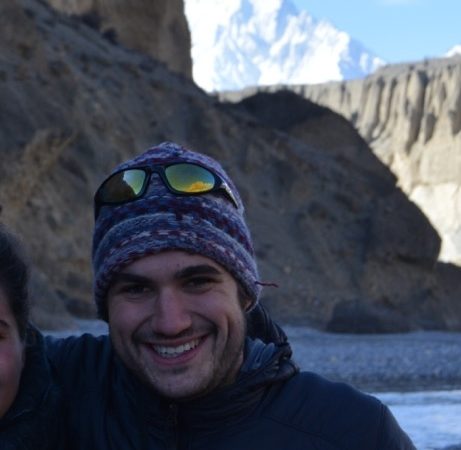Noah Stone ’12 Writes Home from India and Nepal
I have spent about a month in and around the Kathmandu, studying Tibetan Buddhism, the Tibetan language, and other aspects of various Himalayan peoples through SIT, my study abroad program. A month ago we spent a week in India, and I have just returned (a little early) from two weeks in Upper Mustang, an especially remote Tibetanoid region of the Himalaya. In three weeks, I am planning on spending a month in Dolpo, another Himalayan region. In May and June, I will return to India to travel to other parts of Nepal as well.

You don’t have to study geology to appreciate this one. The sequence to the left represent a period when this entire region was glaciated, resulting in rivers and lakes that deposited the sediment. Since that time, the powers of water and erosion have carved out a valley.
Like many students, when I graduated Waynflete in 2012, I wasn’t sure what I wanted to study in college. Instead of attending school immediately, I took a semester to travel the world, work, and perhaps learn something of myself. At Middlebury, I decided to major in geology after taking a few classes in the department. I love geology for its focus on time spent outside, in the field, among the rocks, trees, and snow. It is a science that is expansive and encompassing, as it includes aspects of chemistry, physics, and biology.
When my sophomore year at Middlebury came around, I was ambivalent about studying abroad. I didn’t feel a call away from the dark snow-filled winters of Vermont, as many do, yet I longed for adventure, open space, and growth. SIT, a popular study abroad organization, has programs in more than thirty countries around the world. They place an emphasis on experiential, field-based learning that revolves around homestays, interviews, and the sensory experience. After reading some of their material I decided this was the perfect program for me. Though it doesn’t deal with geology, I felt that SIT added to my education as student of the world.
 My particular program – Nepal: Tibetan and Himalayan Peoples – concentrates on Tibetan refugees living in Nepal and the lives of their counterparts in mainland Tibet. Students live with Tibetan families in Kathmandu, and learn about their language, culture, history, way of life, religion, border politics, and struggles as a people. The program also deals with various Tibetanoid and Himalayan peoples, including Dolpo, Sherpa, and Mustangi people.
My particular program – Nepal: Tibetan and Himalayan Peoples – concentrates on Tibetan refugees living in Nepal and the lives of their counterparts in mainland Tibet. Students live with Tibetan families in Kathmandu, and learn about their language, culture, history, way of life, religion, border politics, and struggles as a people. The program also deals with various Tibetanoid and Himalayan peoples, including Dolpo, Sherpa, and Mustangi people.
Recently, we just returned from two weeks in Upper Mustang, a high alpine dessert region tucked away in the mountains. Hidden in a sandstone valley carved deep through the millennia, Mustang is one of the more remote regions of the Trans Himalaya, and has struggled in the face of rapid modernization in the last five years. I had to leave the trip a bit early, but nonetheless I managed to capture some good pictures of this beautiful and harsh landscape. I have taken over five thousand digital photos since coming to Nepal this past February, a hundred or so of which I have put on a blog (link below).
Every SIT program culminates in month long independent study, where each student travels and researches a topic of choice by themselves. In two weeks, I will be headed to Dolpo, another remote Himalayan district. It will take two flights and three days of walking to reach the valley where I will stay; there are no roads in Dolpo. I will study yartsagunbu, a fungus whose market valley has skyrocketed in the last twenty years. Valued by the Chinese for its properties as an aphrodisiac, yartsagunbu is now the most expensive biological commodity in the world. Its overharvest, mostly by foreigners, has lead to flagrant humans rights and environmental violations that I will be investigating. I will take many pictures during my time in Dolpo, and in my travels in India and Nepal after the conclusion of this program.
I update the blog every few days. Here is the link. Be sure to check in often!




